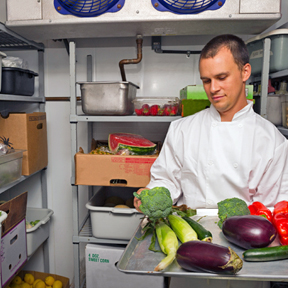No-cost ways to save money with coolrooms and freezer rooms
Keep the room full
Keeping the room at close to its optimum storage capacity (66% for coolrooms and 75% for freezers) is more efficient than running a room half full. Refrigerated product adds thermal mass and reduces a system’s running time and cycling.
Applying capacity control by using a variable-speed compressor reduces these issues. Be careful that stored stock does not block the airflow to and from the evaporators in the room.
Have a loading and unloading policy
When product arrives, you need to ensure that it doesn’t warm up any more than necessary, so load it as quickly as possible into your freezer.
Unfrozen items will freeze quicker if you separate and scatter them around your freezer (after the items are frozen, you can bring them back together in the same part of the freezer). You should also place high-turnover product near the doors for easy access. This will minimise the loss of chilled air.
Keep the door closed
Ambient air entering the room causes a significant load on the system. The ingress of moisture in the air can cause frost to form on evaporators, products, ceilings and floors. Ensure doors are self-closing. Never chock them open; ensure they seal tightly and quickly.
An audible alarm or flashing indicator is a great way to avoid inadvertently leaving a door open even fractionally. Use strip curtains wherever possible.
Turn the lights off
Lights within a refrigerated space introduce a heat load onto the system. Lights should be turned off when the room is not occupied. This can be automated by occupancy sensors or door-limit switches.
Note that building regulations require lights to be operable from within the room.
Learn how to drive
Know how to control your system, select the highest operating temperature suitable for your product, and don’t overuse your system. Normal design temperatures are typically coolrooms from 0–4 °C, and freezer rooms from -18 to -20°C.
The actual operating temperature set point should be selected on the optimum temperature and humidity required for the type of product being stored, and no colder. Over-cooling costs money. Regularly check and calibrate temperature sensors.
Leaks cost money
Keep the refrigerants inside the system, monitor refrigerant use and eliminate all leaks.
Alchester Village Quality Meats, VIC
“We put plastic strips on the inside of the fridge door – so that there is not a gust of cold air going out and a gust of hot air coming in,” said Alchester Village Quality Meats co-owner Sean Hopkins. “This has reduced temperature loss so that an even temperature is maintained and the fridge doesn’t have to work so hard.”
“Now with our fridges and cabinets we might have a fluctuation of one degree and the motors kick in when they need to, so they’re running much less.” These changes are contributing to savings of $2,000 a year in overall energy bills.[1]
Size really does matter
It is important to have a clear definition of the refrigeration space required for your business needs. Oversizing the rooms or equipment ‘just in case’ or selecting the ‘next size up’ will impose an initial capital-cost penalty and ongoing energy-cost penalty.
Specify exactly what you need and expect from your system. Poorly specified systems tend to have the lowest capital costs but the highest operating costs, as well as the shortest useful life.
Ask your expert to pay particular attention to part-load energy performance during the system design.[2]


